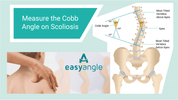-

, by Marko Dombi Athlete-Centric Care: Elevating ACL Rehab with Next-Gen Performance Tools
-

, by Marko Dombi Launch of the EasyBase - Force Plate System For Rehabilitation and Sports
-

, by Marko Dombi Interview with the researcher | Enhanced Paper Grip Test Project
Cobb Angle and Spinal Range of Motion Assessment and Scoliosis with EasyAngle
- , by Jerker Skogby
- 3 min reading time


To measure the Cobb angle, X-ray has been most commonly used method for decades. For teenage girls with idiopathic adolescent scoliosis, the exposure to radiation from X-ray can increase their risk of developing breast-cancer or becoming infertile. (1) It is estimated that girls have an average of 22 X-rays during a three-year treatment period. In an attempt to mitigate this risk, radiologists take the X-ray in the posteroanterior position. New X-ray systems have also been developed to further help reduce the radiation.
In some countries, school-based screening programs are in place to assess spinal deformities in children and teenagers. In the US, where these programs are mandated in some states, the value and cost effectiveness are often debated. As scoliosis is a three-dimensional deformity, it is important to be able to measure the spine in all three planes, which is why X-ray is a popular choice, however, it also drives healthcare costs.
The EasyAngle Digital Goniometer is an effective, and safe device for measuring Range of Motion of the spinal column in all three planes. EasyAngle can measure the Cobb Angle in scoliosis in just two clicks. As such, it can be used to significantly reduce costs for school screening programs. EasyAngle also performs the same function as a scoliometer, where the patient can bend the upper body forward while the device is moved along the spine to assess for deformities. Kyphosis and lordosis angles can also be easily measured using EasyAngle.
How to measure the Cobb angle on scoliosis
For measuring the Cobb Angle, first estimation of degrees of caudal and cranial vertebrae angles should be done with other well-established diagnostic methods, as manual palpatory techniques hardly meet the criteria of validity and reliability. Before measuring with EasyAngle directly on the patient's body with EasyAngle, the clinician should have identified those body landmarks with an established method. Positioning of EasyAngle should be done according to those identified landmarks.
Once caudal and cranial vertebra are identified, monitoring and follow-up of the Cobb angle using EasyAngle requires that you first palpate those vertebrae that are out of alignment (having this information previously confirmed with the initial X-ray). It is useful to mark these with a felt pen before taking the measurement. The measurement button is pressed to get a blinking zero. This lets us know we are ready to select the plane of measurement. The device is then aligned centrally on the first vertebrae that is out of alignment. The measurement button is clicked to begin the measurement. The device is then aligned centrally on the last vertebrae that is out of alignment. The measurement button is clicked again to end the measurement.
Using EasyAngle for patient motivation
One of the great benefits of using EasyAngle is that you can immediately show the number to the patient. As they progress with treatment, they see the number changing and are motivated to continue with their therapy. Positive improvements in the angle are very encouraging for both patients and parents/guardians.
If you are interested in finding out more, contact the Meloq team or join one of our interactive demos where we can show you just how easy it is to use EasyAngle to quantify your work.
*Disclaimer: Meloq currently does not recommend the use of EasyAngle for diagnosing scoliosis. As of 2021. three research projects were started with an aim to investigate the reliability and validity for this application. Until this is confirmed, EasyAngle can be used to follow-up, monitor the spinal range of motion as well as the changes in Cobb.
References:
- Risks of exposure to X-rays in patients undergoing long-term... : JBJS [Internet]. [cited 2022 Apr 11]. Available from: the journal of bone and joint surgery
Tags
Comments
-
What a fantastic post! This blog is so full of useful information i can’t wait to dig deep and start utilizing the resources you have given me. i have similar article that will surely help. Breast Cancer



